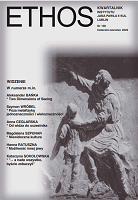„...A NADE WSZYSTKO, BYŚCIE ZOBACZYLI” PODMIOT I WZROK W OPOWIADANIU JOSEPHA CONRADA U KRESU SIŁ
„...IT IS, BEFORE ALL, TO MAKE YOU SEE”: SUBJECT AND SEEING IN “THE END OF THE TETHER” BY JOSEPH CONRAD
Author(s): Katarzyna SokołowskaSubject(s): Polish Literature, Theory of Literature, British Literature, Sociology of Literature
Published by: Katolicki Uniwersytet Lubelski Jana Pawła II - Instytut Jana Pawła II, Wydział Filozofii
Keywords: Joseph Conrad; sight; blindness; the subject; representation;
Summary/Abstract: Joseph Conrad’s novella “The End of the Tether,” written in his mature phase, concludes the trilogy featuring such iconic texts as “Youth” and “Heart of Darkness.” The central theme of the story is the tragedy of Captain Whalley, an outstanding sailor who trusts that nothing would shatter his life. However, when he faces bankruptcy he has to swallow his pride and secures a job as the captain of a steamer. Soon, affected by eyesight deterioration and eventually blindness, Whalley compromises his integrity and conceals his vision loss, thus putting the ship in danger. Whalley’s attitude is representative of the modern subject, the cogito, who recognizes himself as a source of perceptual and cognitive certainty, and seeks to confi rm the position of power and control both over himself and over external reality. Levin relates this model of subjectivity to the style of seeing that confronts the perceiving “I” with the object in front of it and turns Being into representation. Discarding the ocularcentric tradition with its affi rmation of sight as an instrument of reaching the truth, Levin maintains that sight isolates an object in the fl ux of sensations, immobilizes it in order to make it open to scrutiny and, thus, expresses the will to power that correlates with the desire for certainty. The motif of Whalley’s declining eyesight undermines his status of the subject, the Cartesian cogito, who establishes himself as the centre and, eager to assert his will, aspires to creating coherent representations. The images of darkness, glaring light and a multitude of tangled or disintegrating shapes subvert representation and foreshadowing the protagonist’s blindness, invoke questions on the relationship between the perceiving subject and reality which are typical of Conrad’s fi ction and modernist literature.
Journal: Ethos. Kwartalnik Instytutu Jana Pawła II KUL
- Issue Year: 35/2022
- Issue No: 2
- Page Range: 245-264
- Page Count: 20
- Language: Polish
- Content File-PDF

